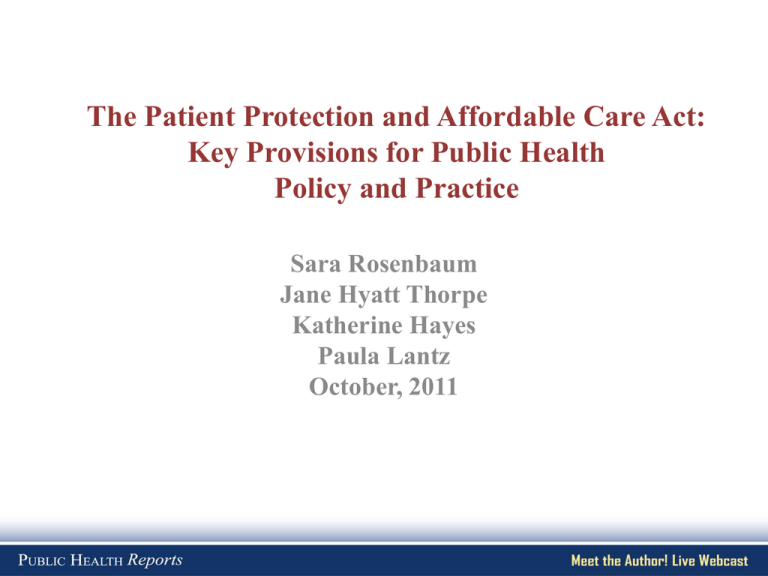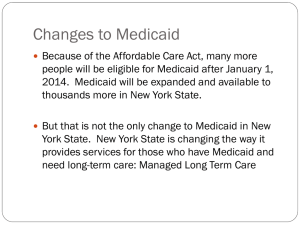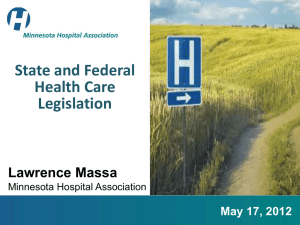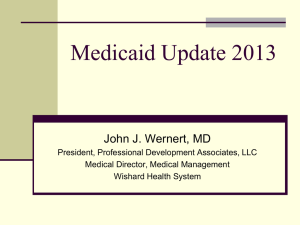Webcast Powerpoint - Public Health Reports
advertisement

The Patient Protection and Affordable Care Act: Key Provisions for Public Health Policy and Practice Sara Rosenbaum Jane Hyatt Thorpe Katherine Hayes Paula Lantz October, 2011 Introduction • The Patient Protection and Affordable Care Act (Affordable Care Act) and the Health Care and Education Reconciliation Act (HCERA) Enacted March 23, 2010 Major evolution in longstanding federal laws in order to achieve coverage for nearly all Americans (92% of population including persons not lawfully present in the U.S., 94% of all persons lawfully present) Pluralistic approach (employer-sponsored coverage, Medicaid, individual coverage through state insurance Exchanges) Reforms aimed at improving the public’s health and health care quality and efficiency • Comprehensive information about the legislation and federal implementation, as well as library of relevant reports and articles at Health Reform GPS (www.healthreformgps.org), a joint project of the Robert Wood Johnson Foundation and the Hirsh Health Law and Policy Program of the GW SPHHS department of health policy. Getting There by 2014 • Transforming the insurance market: Bars insurers selling individual and group policies from barring access or charging premiums based on health status • Shared responsibility: Requires large (>50 fulltime workers) employers who do not insure their employees or who offer unaffordable coverage (>9% of employee modified adjusted gross income) to contribute to the cost of coverage; requires individuals to either buy affordable coverage or pay a penalty • Exchanges: Establishes state insurance Exchanges to provide access to affordable coverage through “qualified health plans” for “qualified” individuals and “qualified” small employer groups. Premium subsidies for individuals with incomes between 133% and 400% FPL (cost-sharing assistance also provided). • Medicaid: Expand Medicaid for the poorest Americans (<133% FPL) Estimated Health Insurance Coverage in 2019 Total Nonelderly Population = 282 million SOURCE: Kaiser Family Foundation analysis of Congressional Budget Office estimates, March 20, 2010 PRIVATE INSURANCE REFORMS (Pre-2014) DEPENDENT COVERAGE* To age 26 PREVENTIVE BENEFITS EFFECTIVE: 1st Plan Year after 09/10 Preventive benefits with no cost-sharing: A or B (USPSTF). ACIP- recommended immunizations, Preventive care for children & additional care/screenings for women recommended by HRSA. PRE-EXISTING CONDTIONS No pre-existing condition exclusions for children <19 TAX CREDITS,HIGH RISK POOLS, REINSURANCE FOR OLDER WORKERS Small employer tax credit (<25 employees moderate average annual wage; pre-existing condition plan: individuals with pre-existing conditions and uninsured for 6 months or longer; reinsurance for retiree plans PATIENT PROTECTIONS AND APPEALS Emergency coverage; direct access to pediatrician and ob-gyn; internal and external appeals RECISSIONS* Barred except in cases of intentional fraud LIFETIME CAPS* ANNUAL LIMITS WAITING PERIODS* RESCISSIONS Lifetime caps barred Annual limits regulated Waiting periods regulated Rescissions barred PREMIUMS Rate reviews for unreasonable rate increases, beginning 2010 MEDICAL LOSS RATIO RATE REVIEWS Medical loss ratio reporting, rebates in 2011 for group plans not meeting 85% MLR & individual plans not meeting 80% MLR Annual CONSUMER WEBSITE Consumer website and information improvement PRIVATE INSURANCE REFORMS (2014) State Insurance Exchanges (state or federally operated) Individuals and small groups (100 or fewer FT employees, state option to set at 50 or fewer until 2016) purchase “qualified health plans.” Premium subsidies and cost-sharing assistance Insurance market reforms 1. 2. 3. 4. 5. 1. 2. No pre-existing condition exclusion Discrimination on health status barred (wellness program exception) Excessive waiting periods barred Lifetime and annual limits barred Coverage for routine costs related to approved clinical trials Annual limits on out-of-pocket spending Essential benefit coverage requirements in the individual and small group markets Exceptions for “Grandfathered” Health Plans State Insurance Exchanges • Broad state discretion Whether to establish by January 2014 Structure and governance Whether to keep non-Exchange markets Degree of Medicaid integration Qualified health plan (QHP) standards across “insurance affordability programs” (Medicaid, CHIP, state basic health programs, premium credits) Whether to continue state benefit mandates for Exchange plans Role of Navigators Medicaid • Children and all non-elderly adults who are ineligible for Medicare, with modified adjusted family incomes (MAGI) below 133% FPL; enhanced FMAP for newly eligible adults (100% dropping to 90% by 2020) • Retains traditional Medicaid eligibility standards (which may be higher) for persons with disabilities • Streamlined eligibility determination and redetermination process with online applications and enrollment through Exchanges • “Benchmark” coverage for newly eligible persons paralleling “essential health benefits” and including preventive coverage • Reforming care for “dual eligibles” • Increased Medicaid payments for primary health care • Pre-2014 expanded eligibility for family planning and “family planning-related” services Quality and Efficiency • Center for Medicare and Medicaid Innovation (CMI) to “test innovative payment and service delivery models to reduce program expenditures under [Medicare and Medicaid] while preserving or enhancing the quality of care. . ..” • National Quality Strategy to set priorities to improve the delivery of health care services, outcomes, and population health, and to create processes for development of quality measures. • Encouraging high-quality care at lower cost: Expand quality measurement and reporting programs for hospitals, physicians New quality measurement and reporting programs for long-term care hospitals, inpatient rehab hospitals, hospice, and non-PPS exempt cancer hospitals Value-based purchasing programs for hospitals and physicians; CMS to develop VBP plans for ambulatory surgery centers, skilled nursing facilities, and home health Additional payment incentives (bundled payments, non-payment for hospital-acquired conditions, reduced payments high readmission rates) Bonus payments for high performing Medicare Advantage plans Medicare medical homes/Medicaid health homes Medicare Shared Savings Program – Accountable Care Organizations • Patient-Centered Outcomes Research Institute for comparative effectiveness research Wellness and Prevention • Recommended preventive care fully covered with no co-pays and deductibles • Annual wellness exam in Medicare • Employer wellness programs incentivized • Sustained funding for prevention and public health – Public Health Trust Fund and Community Transformation Grants • Calorie information on restaurant menus Copyright - AHA Confidential & Proprietary 10 Creating Access and Expanding Hospitals’ “Community Benefit” Obligations • Health center expansion and National Health Service Corps • Expanded “community benefit” obligations for nonprofit hospitals through community health needs assessment, implementation strategies, and public health consultation Key Issues for Public Health Policy and Practice • • • • Reforming state insurance laws Implementing Medicaid expansions Setting up insurance Exchanges Enrolling the uninsured and reducing “churning” across Medicaid and Exchanges • System transformation in Medicaid for individuals at greatest health risk • Community benefits and integration with community transformation • Transition to a value-based system of care











